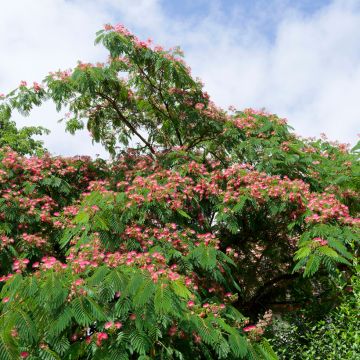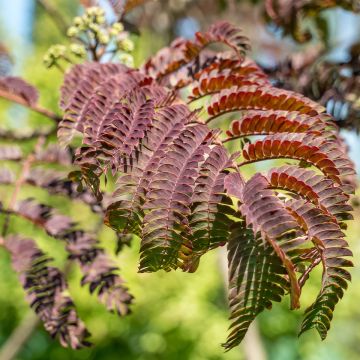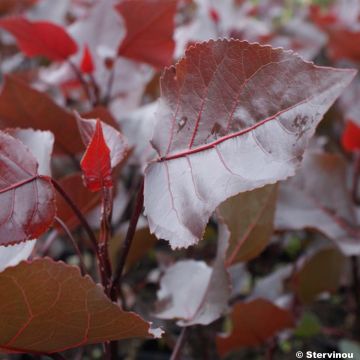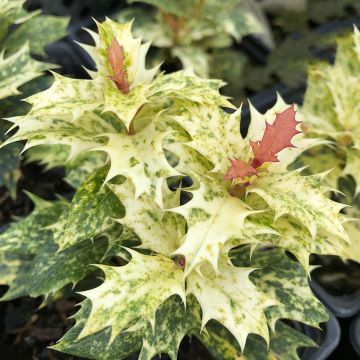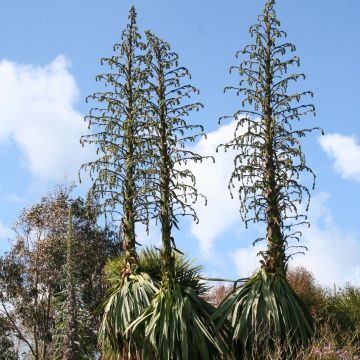

Albizia julibrissin Rouge de Tuiliere


Albizia julibrissin Rouge de Tuiliere


Albizia julibrissin Rouge de Tuiliere
Albizia julibrissin Rouge de Tuiliere
Albizia julibrissin Rouge de Tuilière
Persian Silk Tree, Pink Silk Tree, Mimosa Tree, Silk Tree, Persian Acacia
This item cannot be shipped to the selected country
Delivery charge from €5.90
Delivery to Corse prohibited
More information
Schedule delivery date,
and select date in basket
This plant carries a 24 months recovery warranty
More information
We guarantee the quality of our plants for a full growing cycle, and will replace at our expense any plant that fails to recover under normal climatic and planting conditions.
From €5.90 for pickup delivery and €6.90 for home delivery
Express home delivery from €8.90.
Delivery to Corse prohibited: UE law prohibits the import of this plant from mainland France to Corse as part of the fight against Xylella fastidiosa. Please accept our sincere apologies.
More information
Does this plant fit my garden?
Set up your Plantfit profile →
Description
Albizia julibrissin 'Rouge de Tuiliere' is a variety of silk tree that offers spectacular summer flowering, with clusters of silky pompoms in a reddish pink. Like all albizias, this small tree has a characteristic graceful habit, like an umbrella, as well as finely cut mimosa-like foliage. It provides light shade, and its foliage appears fairly late in spring. These qualities make it an excellent small shade tree for a terrace. In addition to its ornamental qualities, the 'Rouge de Tuiliere' Albizia is a particularly hardy selection, suitable for many regions.
Albizia julibrissin 'Rouge de Tuiliere' is a horticultural creation. The species, sometimes called the Persian silk tree, is a deciduous small tree in the Fabaceae family, whose range extends from Iran to eastern China. The 'Rouge de Tuiliere' variety can reach 7-8 m (23 - 26 ft) in height with almost the same spread. It blooms from July to September, producing fluffy and silky flower clusters that have earned it the name silk tree. They are composed of several "pompoms" made up of 5 cm (2 in) long stamens, with an intense red-pink colour at the base, lighter at the tip, clearly visible, surpassing the rudimentary corollas grouped in heads. The scent of the flowers is most noticeable up close, powdery and sweet. The flowering gives way to a fruit, a flat pod 8 to 20 cm (3 - 8 in) long, initially green then brown, containing 5 to 15 fairly large oval seeds, which germinate easily. The deciduous leaves, a fairly light green, are very large, measuring from 15 to 40 cm (5 - 15 in). They hang gracefully from the drooping branches. Each leaf is composed of large leaflets, themselves subdivided into small leaflets. These leaflets fold up in the evening and unfold in the morning. The bark of the Albizia is thin, grey-green then grey, almost smooth, with whitish lenticels. Characteristic of plants in the Fabaceae family, the roots form nodules capable of fixing atmospheric nitrogen through specific bacteria present in these organs. The taproot system of this small tree does not tolerate transplanting well. The lifespan of the Albizia is variable, in European climates it usually reaches around thirty years.
The Albizia, with its airy and graceful silhouette, is planted as a solitary bush to provide light shade, to a terrace in particular. Despite its exotic appearance, it is a relatively easy tree to cultivate, not very demanding and fairly resistant to cold, depending on the variety. In mild climates, where winters are not too harsh, combine it with oleanders and pittosporums. The hardy Rouge de Tuiliere variety will benefit from being planted in well-drained soil, in full sun, sheltered from cold winds. Stake young plants in windy regions; strong winds can break its branches.
Report an error about the product description
Albizia julibrissin Rouge de Tuiliere in pictures
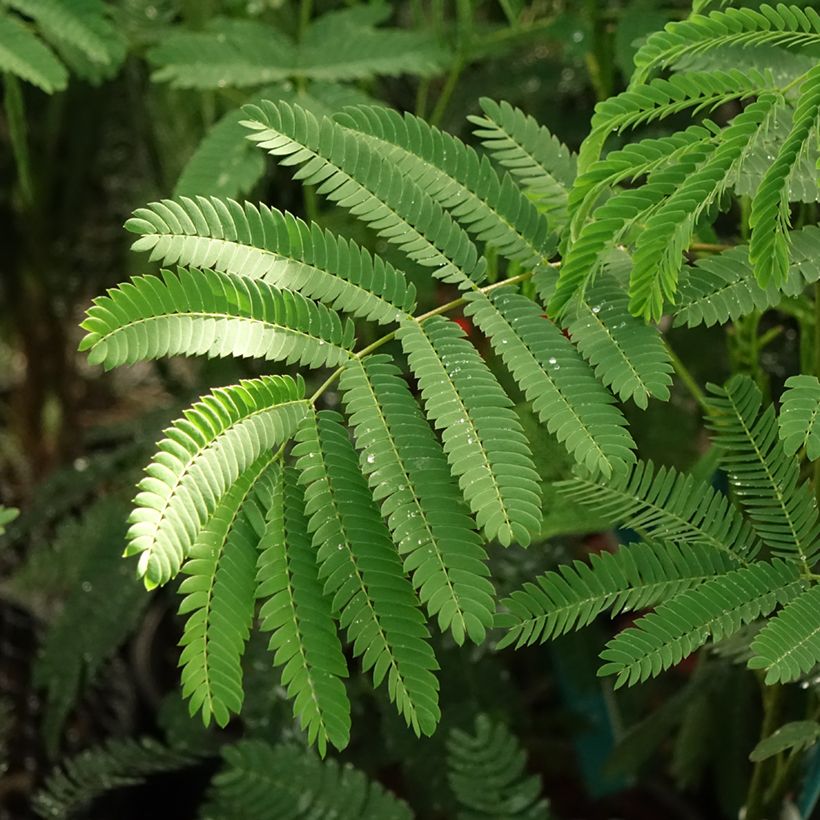

Plant habit
Flowering
Foliage
Botanical data
Albizia
julibrissin
Rouge de Tuilière
Fabaceae
Persian Silk Tree, Pink Silk Tree, Mimosa Tree, Silk Tree, Persian Acacia
Cultivar or hybrid
Other Albizia
Planting and care
Albizia 'Rouge de Tuiliere' is preferably planted in early autumn in regions with a mild climate or in late winter in regions subject to cold winters. Resistant down to -15°C, choose a warm location, in full sun and sheltered from cold winds. Young plants must be securely staked, especially in windy regions. Strong winds can break its branches. In late winter, between February and March and before the start of vegetation, prune out dead, diseased or obstructing stems to maintain a beautiful habit. Robust pruning stimulates numerous vigorous shoots from the stump. Once well-established, the Albizia withstands summer drought well. It tolerates limestone and relatively poor soils.
Albizia is naturally resistant to diseases, but it can be damaged by the silk tree psyllid (Acizzia jamatonica). This is a tiny "false aphid", yellow-green to brownish in colour, which proliferates in colonies on foliage that it pierces to extract sap. In cases of mass infestation, the foliage dries up and the tree weakens. The honeydew secreted by the psyllid also induces the formation of black sooty mould. Treatments are difficult due to overlapping generations and the protection provided by the waxy excretions of the insects. The Albizia psyllid, of Asian origin, particularly affects warmer regions. It was first detected in Vaucluse in 2004, then in Languedoc-Roussillon in 2005. This parasite is currently spreading steadily in Europe. Its natural enemies seem to be the Asian ladybug, as well as Syrphid larvae and certain bugs.
Planting period
Intended location
Care
-
, onOrder confirmed
Reply from on Promesse de fleurs
Striking foliage shrubs
Haven't found what you were looking for?
Hardiness is the lowest winter temperature a plant can endure without suffering serious damage or even dying. However, hardiness is affected by location (a sheltered area, such as a patio), protection (winter cover) and soil type (hardiness is improved by well-drained soil).

Photo Sharing Terms & Conditions
In order to encourage gardeners to interact and share their experiences, Promesse de fleurs offers various media enabling content to be uploaded onto its Site - in particular via the ‘Photo sharing’ module.
The User agrees to refrain from:
- Posting any content that is illegal, prejudicial, insulting, racist, inciteful to hatred, revisionist, contrary to public decency, that infringes on privacy or on the privacy rights of third parties, in particular the publicity rights of persons and goods, intellectual property rights, or the right to privacy.
- Submitting content on behalf of a third party;
- Impersonate the identity of a third party and/or publish any personal information about a third party;
In general, the User undertakes to refrain from any unethical behaviour.
All Content (in particular text, comments, files, images, photos, videos, creative works, etc.), which may be subject to property or intellectual property rights, image or other private rights, shall remain the property of the User, subject to the limited rights granted by the terms of the licence granted by Promesse de fleurs as stated below. Users are at liberty to publish or not to publish such Content on the Site, notably via the ‘Photo Sharing’ facility, and accept that this Content shall be made public and freely accessible, notably on the Internet.
Users further acknowledge, undertake to have ,and guarantee that they hold all necessary rights and permissions to publish such material on the Site, in particular with regard to the legislation in force pertaining to any privacy, property, intellectual property, image, or contractual rights, or rights of any other nature. By publishing such Content on the Site, Users acknowledge accepting full liability as publishers of the Content within the meaning of the law, and grant Promesse de fleurs, free of charge, an inclusive, worldwide licence for the said Content for the entire duration of its publication, including all reproduction, representation, up/downloading, displaying, performing, transmission, and storage rights.
Users also grant permission for their name to be linked to the Content and accept that this link may not always be made available.
By engaging in posting material, Users consent to their Content becoming automatically accessible on the Internet, in particular on other sites and/or blogs and/or web pages of the Promesse de fleurs site, including in particular social pages and the Promesse de fleurs catalogue.
Users may secure the removal of entrusted content free of charge by issuing a simple request via our contact form.
The flowering period indicated on our website applies to countries and regions located in USDA zone 8 (France, the United Kingdom, Ireland, the Netherlands, etc.)
It will vary according to where you live:
- In zones 9 to 10 (Italy, Spain, Greece, etc.), flowering will occur about 2 to 4 weeks earlier.
- In zones 6 to 7 (Germany, Poland, Slovenia, and lower mountainous regions), flowering will be delayed by 2 to 3 weeks.
- In zone 5 (Central Europe, Scandinavia), blooming will be delayed by 3 to 5 weeks.
In temperate climates, pruning of spring-flowering shrubs (forsythia, spireas, etc.) should be done just after flowering.
Pruning of summer-flowering shrubs (Indian Lilac, Perovskia, etc.) can be done in winter or spring.
In cold regions as well as with frost-sensitive plants, avoid pruning too early when severe frosts may still occur.
The planting period indicated on our website applies to countries and regions located in USDA zone 8 (France, United Kingdom, Ireland, Netherlands).
It will vary according to where you live:
- In Mediterranean zones (Marseille, Madrid, Milan, etc.), autumn and winter are the best planting periods.
- In continental zones (Strasbourg, Munich, Vienna, etc.), delay planting by 2 to 3 weeks in spring and bring it forward by 2 to 4 weeks in autumn.
- In mountainous regions (the Alps, Pyrenees, Carpathians, etc.), it is best to plant in late spring (May-June) or late summer (August-September).
The harvesting period indicated on our website applies to countries and regions in USDA zone 8 (France, England, Ireland, the Netherlands).
In colder areas (Scandinavia, Poland, Austria...) fruit and vegetable harvests are likely to be delayed by 3-4 weeks.
In warmer areas (Italy, Spain, Greece, etc.), harvesting will probably take place earlier, depending on weather conditions.
The sowing periods indicated on our website apply to countries and regions within USDA Zone 8 (France, UK, Ireland, Netherlands).
In colder areas (Scandinavia, Poland, Austria...), delay any outdoor sowing by 3-4 weeks, or sow under glass.
In warmer climes (Italy, Spain, Greece, etc.), bring outdoor sowing forward by a few weeks.




































